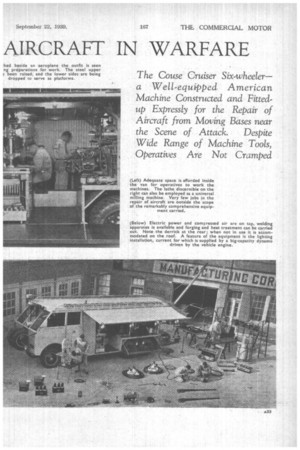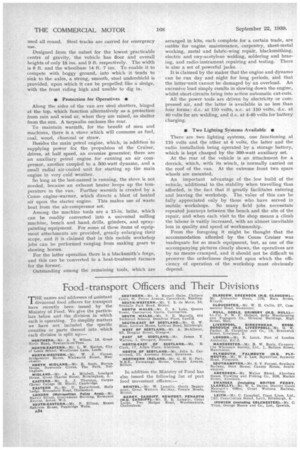A MOBILE WORKSHOP AIRCRAFT IN WARFARE
Page 34

Page 35

Page 36

If you've noticed an error in this article please click here to report it so we can fix it.
The souse Cruiser Six-wheeler
a Well-equipped American Machine Constructed and Fitted up Expressly for the Repair of Aircraft from Moving Bases near the Scene of Attack. Despite Wide Range of Machine Tools,
Operatives Are Not Cramped UNDER war conditions, the efficient operation of aircraft not only gains in importance but , also becomes more difficult. The aeroplane's dependence on land
transport is greater than ever, and the all-embracing field of usefulness of the commercial motor is once more in evidence.
Flying grounds at temporary bases close to the attack are imperfectly levelled, and cleared, and areun • familiar, to pilots, whilst landings MuSt Often be made in bad weather.
'These are but a few of the many causes of damage to machines much
in excess of normal. Facilities for .repair, therefore, must be proportionally adequate.
. Obviously, the temporary airport cannot be equipped to the same standard as its permanent counterpart, so
• the mobile Workshopis called in. For this, conditions
dictate a number of characteristics that are by. no means . easy to combine, and, as an example of a fine achieve
ment in this branch of transport which has suddenly•found itself in a position of the first importance and interest, we illustrate and outline., in respect of its salient features, an outfit of the type in point, from
across the Atlantic.
It represents an effort to meet requirements by Cause Laboratories, Inc., East Orange, N.J., U.S.A., the products of which organization are handled in this country by Messrs. Spingarn Boardman, 40, Piccadilly, London, W.1, and it is named the Couse Cruiser, or . Come Mobile Airport.
Not Only is it the aircraft that are affected by the adverse local conditions but also the .ground transport, A..12 notably the mobile workshop_ Rough, and probabl5 soft, the landing ground itself constitutes difficult terrain, whilst access. to it will assuredly be little, if any better. Nevertheless, it is essential that the workshol lorry be swift and Cure in reaching its objective, ant capable of successfully negotiating mud, sand or snow The designer is in no way assisted by .the awkwarc load, for lathes, drills, and other machine-shop equip merit are liable to be top-heavy when mounted on standard chassis.
It might be thought that a trailer hauled by a tract°. would be preferable for the purpose, but in point o fact the self-propelled unit has definite advantages Many readers have seen the capabilities over rougl country of British machines with four-wheel drive it our War Office Trials, and will appreciate this point.
The Couse Cruiser is a six-wheeler, with twin tyre on the four rear wheels, all of which are. driven. Fire stone Ground Grip 32 by 6 low-pressure equipment i
used all round. Steel tracks are carried for emergency use.
Designed from the outset for the lowest practicable centre of gravity, the vehicle has floor and overall heights of only 18 ins. and 9 ft. respectively. The width is 8 ft. and the wheelbase 14 ft. 7 ins. To enable it to compete with boggy ground, into which it tends to sink to the axles, a strong, smooth, steel undershield is provided, upon which it can be propelled like a sledge, with the front. riding high and unable to dig in.
• Protection for Operatives • Along the sides of the van are steel shutters, hinged at the top, which function alternatively as a protection from rain and wind or, when they are raised, as shelter from the sun. A tarpaulin encloses the rear.
To maintain warmth, for the benefit of men and machines, there is a stove which will consume as fuel, coal, wood, charcoal or straw.
Besides the main petrol engine, which, in addition to supplying power for the propulsion of the Cruiser, drives, at half speed, an oversize generator; there are an auxiliary petrol engine for running an air compressor, another coupled to a 300-watt dynamo, and a small radial air-cooled unit for starting up the main engine in very cold weather.
So long as the last-named is running, the stove is not needed, because an exhaust heater keeps up the temperature in the van. Further warmth is created by a Couse engine-warmer, which directs a blast of heated air upon the starter engine. This makes use of waste heat from the air-compressor set.
Among the machine tools are a 15-in, lathe, which can be readily converted into a universal milling machine, bench and handdrills, grinders, and spraypainting equipment. For some of these items of equipment attachments are provided, greatly. enlarging their scope, and it is claimed that in this mobile workshop jobs can be performed ranging from making gears to shoeing horses.
For the latter operation there is a blacksmith's forge, and this can be converted to a heat-treatment furnace for the former.
Outstanding among the remaining tools, which are
arranged in kits, each complete for a certain trade, are outfits for engine. maintenance, carpentry, sheet-metal working, metal and fabric-wing repair, blacksmithing, electric and oxy-acetylene welding, soldering and brazing, and radio-instrument repairing and testing. There is also a set of powerful jacks.
It is claimed by the maker that the engine and dynamo can be run day and night for long periods, and that the latter•unit cannot be damaged by an overload. An excessive load simply results in slowing down the engine, , whilst short-circuits bring into action automatic cut-outs. All the power tools are driven by electricity or compressed air, and the latter is available in no less than four forms: d.c. at 110 volts, ac. at 110 volts, d.c. at 40 volts for arc welding, and d.c. at 4-40 volts for battery charging.
• Two Lighting Systems Available • There are two lighting systems, one functioning at 110 volts and the other at 0 volts, the latter and the radio installation being operated by a storage battery, which is kept charged by the 300-watt auxiliary set.
At the rear of the vehicle is an attachment for a derrick, which, with its winch, is normally carried on the roof of the van. At the extreme front two spare wheels are mounted.
An important advantage of the low build of the vehicle, additional to the stability when travelling thus afforded, is the fact that it greatly facilitates entering and leaving the workshop. The value of this can be fully appreciated only by those who have served in mobile workshops. So many field jobs necessitate repeated journeys between the bench and the site of the repair, and when each visit to the shop means a climb the labour is vaStly increased, with an almost inevitable loss in quality and speed of workmanship.
From the foregoing it might be thought that the accommodation afforded by the Couse Cruiser was inadequate for so much equipment, but, as one of the accompanying pictures clearly shows, the operatives are by no means cramped, and it should not be difficult to preserve the orderliness depicted upon which the efficiency of operation of the workshop must obviously depend.




































































